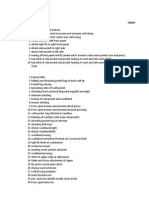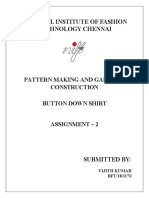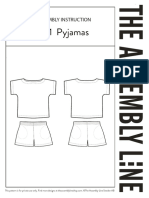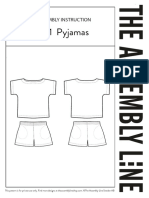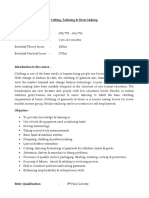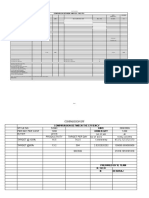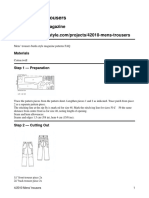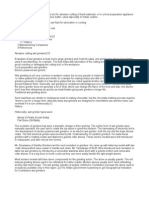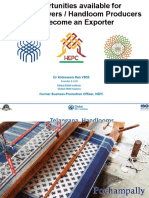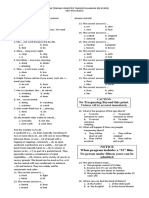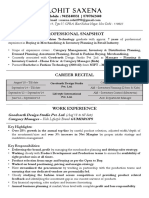QQTITLE: INDUSTRIAL ATTACHMENT REPORT AT BARAKA TAILORING SHOP
NAME: VIOLAH JEMELI
COURSE: FASHION AND DESIGN
COURSE LEVEL: DIPLOMA LEVEL 6
ADM: IM/FD6/3518/24J
INSTITUTION: KEROKA TECHNICAL TRAINING INSTITUTE
SUPERVISOR: LUKA CHELANG’A
i
� DECLARATION
I Violah Jemeli do hereby declare that this report is my original work and best to my knowledge.
It has not been submitted for any diploma award in any institution.
Name: Violah Jemeli
Date: 01/08/2025
Signature: ……………………………………
ii
� DEDICATION
I would like to dedicate the report to my lovely parents for their continuous financial and moral
support. I also appreciate their continued support in all my academic endeavors especially during
my attachment period. I would also like to appreciate the entire Baraka Tailoring Shop fraternity
for equipping me with the necessary knowledge and skills.
iii
� ACKNOWLEDGEMENT
I thank the almighty God for the gift of life during the attachment period. I would also like to
acknowledge my supervisor Mr. Luka Chelang’a for his supervision and his support throughout
the attachment period.
iv
� ABSTRACT
This report provides a summary of the industrial attachment experience carried out at Baraka
Tailoring Shop over a specified period. The main objective of the attachment was to apply
theoretical knowledge gained in class to real-world tailoring tasks and to gain hands-on skills in
garment construction. During the attachment, I was involved in various activities such as fabric
cutting, sewing, garment finishing, taking measurements, and customer service. The report
outlines the tasks performed, skills acquired, challenges encountered, and how they were
managed. It also highlights the lessons learned, including the importance of time management,
teamwork, accuracy, and professionalism in a working environment. The attachment experience
at Baraka Tailoring Shop played a significant role in enhancing my practical skills and preparing
me for the tailoring and fashion industry.
v
�Contents
DECLARATION.......................................................................................................................................ii
DEDICATION..........................................................................................................................................iii
ACKNOWLEDGEMENT........................................................................................................................iv
ABSTRACT...............................................................................................................................................v
CHAPTER ONE........................................................................................................................................1
1.1 COMPANY PROFILE....................................................................................................................1
1.2 COMPANY HISTORY...................................................................................................................1
1.3 OBJECTIVES OF THE COMPANY.............................................................................................1
1.4 COMPANY ORGANIZATION STRUCTURE............................................................................1
CHAPTER TWO.......................................................................................................................................2
2.1 CUTTING A SCHOOL SHIRT UNIFORM WITH A YOKE AT THE BACK.........................2
2.2 BACK BODICE WITH YOKE......................................................................................................2
2.3 HOW TO DRAFT A TROUSER....................................................................................................3
2.4 CUTTING AND MAKING CHILD DRESS WITH LAYERS OF PLEATS AND GATHERS 3
2.5 CUTTING AND MAKING BOWNET ACCESSORIES.............................................................4
2.6 MAKING AND CUTTING A TOTE BAG....................................................................................5
2.7 MAKING A BRIDAL DRESS FOR A CHILD WITH LAYERS FOR COTTON, STIFFNET
AND VELNET.......................................................................................................................................6
2.8 CUTTING AND MAKING A SCHOOL TRACK SUIT TROUSER..........................................6
2.9 MAKING CASUAL SHIRT...........................................................................................................7
2.10 CUTTING AND MAKING PETTICOAT...................................................................................8
2.11 FABRIC DECORATION (SCREEN PRINTING).....................................................................8
CHAPTER THREE.................................................................................................................................10
3.1 CHALLENGES FACED...............................................................................................................10
3.2 CONCLUSION..............................................................................................................................10
3.3 RECCOMMENDATION..............................................................................................................11
vi
� CHAPTER ONE
1.1 COMPANY PROFILE
BARAKA TAILOR SHOP
Mission: To produce and market garments under conditions that confirms to the highest
international standards and qualities.
Vision: To be a leading garment producers in Africa.
1.2 Company History
Baraka Tailoring shop is a private company owned by an individual. It is a sole proprietor
business that started 3 years ago. The shop was opened on a rental and therefore the rent is paid
on monthly basis.
1.3 Objectives of the company
1. To provide quality employment opportunities.
2. To provide quality skills and knowledge to trainers
1.4 Company organization structure
The company is owned by the owner as the manager.
MANAGER
TAILOR PRESSER/IRONER
DESIGNER
vii
� CHAPTER TWO
2.1 CUTTING A SCHOOL SHIRT UNIFORM WITH A YOKE AT THE BACK
1. Begin by pre-washing and ironing the fabric to remove shrinkage and ensure accurate
cutting.
2. Fold the fabric lengthwise with right sides together, aligning the selvage edges along the
grain.
3. Place the back bodice pattern on the fold and cut it up to the yoke line, marking all necessary
notches and grainlines.
4. Cut two yoke pieces on the fold — one for the outer yoke and one for the inner yoke —
ensuring they match the top edge of the back bodice.
5. Position the front bodice pieces on the fabric, adding seam allowance and cutting two mirror
pieces for the left and right fronts.
6. Cut the sleeves, ensuring they are symmetrical, and mark notches for front and back
armholes.
7. Cut the collar and collar stand in pairs (each two pieces), and interface one layer of each for
stability.
8. Cut the shirt pocket (if included), and mark its placement on the front bodice.
9. Transfer all pattern markings to the fabric using tailor’s chalk or a fabric marker.
10. Set all pieces aside in order, ready for sewing, including: front bodice (2), back bodice (1),
yoke (2), sleeves (2), collar (2), collar stand (2), and pocket.
2.2 BACK BODICE WITH YOKE
1. Start by folding the fabric with the right sides together and place the back bodice pattern
on the fold, ensuring the center back lies on the fold line.
2. Cut the back bodice up to the yoke line, which is typically positioned a few inches below
the neckline.
3. Cut two yoke pieces on the fold — one for the outer yoke and one for the inner yoke
(facing), making sure all notches and grainlines are marked.
4. Pin and stitch the outer yoke to the top edge of the back bodice, matching all notches and
shoulder points.
viii
� 5. Press the seam allowance upwards toward the yoke to prepare for clean finishing.
6. Place the inner yoke right sides together with the outer yoke, sandwiching the back
bodice between the two yoke layers.
7. Sew along the neckline and shoulder seams, then trim and notch the curves to reduce
bulk.
8. Turn the inner yoke to the inside, enclosing the seam, and press the entire yoke area
neatly.
9. Finish by topstitching or slip-stitching the inner yoke in place along the inside for a clean
and professional finish.
2.3 HOW TO DRAFT A TROUSER
1. Begin by taking accurate body measurements including waist, hip, crotch depth, waist-to-
hip, thigh, knee, ankle, and outseam.
2. Draw a vertical guideline on your pattern paper to represent the center line and mark
horizontal lines for the waist, hip, crotch, knee, and hem.
3. On the waistline, mark one-quarter of the waist measurement plus dart allowance; on the
hip line, mark one-quarter of the hip measurement.
4. Draw the side seam curve by connecting the waist to the hip using a curved ruler.
5. On the crotch line, extend the crotch width by adding extra allowance and draw the front
crotch curve.
6. Mark the knee and hem widths evenly on both sides of the center line and connect all
points to shape the trouser legs.
7. Trace the front pattern to create the back, adding to the crotch extension, raising the
waistline, and widening the side seams.
8. Add back darts for shaping and ensure all side and inseams align properly with the front
pattern.
9. Add seam and hem allowances around all edges of both front and back trouser patterns.
10. Label the pattern pieces clearly and your basic trouser draft is complete and ready for
cutting.
ix
�2.4 CUTTING AND MAKING CHILD DRESS WITH LAYERS OF PLEATS AND
GATHERS
1. Start by taking accurate body measurements of the child, including chest, waist, shoulder,
dress length, and armhole.
2. Pre-wash and iron the fabric to eliminate shrinkage and ensure smooth, accurate cutting.
3. Fold the fabric with right sides together, align the selvages, and lay out the pattern pieces
for the bodice (front and back), sleeves, and skirt sections.
4. Cut the front and back bodice pieces, ensuring that the back has seam allowance for a
zipper or button opening.
5. Cut the skirt panels wider than the bodice to allow fullness for pleats or gathers; cut
multiple layers if the design includes tiered layers.
6. Cut the sleeves, making sure they are wide enough at the crown to accommodate gathers
or pleats if required in the sleeve design.
7. Transfer all markings such as notches, darts, pleat positions, and center lines using
tailor’s chalk or a fabric marker.
8. Sew the shoulder seams of the bodice, then attach the neckline facing or lining if
included.
9. Prepare the skirt layers by forming the pleats or gathers evenly along the top edge,
matching the width of the bodice.
10. Attach the gathered or pleated skirt to the bodice, aligning side seams and center points
for even distribution.
11. Sew the side seams of the dress from sleeve to hem in one continuous line if the dress is
unlined.
12. Attach the sleeves to the armholes, easing or gathering the sleeve cap to fit smoothly.
13. Insert the zipper or button placket at the center back or side opening as required.
14. Finish the neckline, sleeve hems, and skirt hem with appropriate finishing methods such
as bias binding, facing, or narrow hemming.
15. Press the entire dress neatly, especially the pleats and gathers, to enhance the shape and
give a clean finish.
x
�2.5 CUTTING AND MAKING BOWNET ACCESSORIES
1. Choose a soft fabric like satin, silk, Ankara, or cotton, and press it to remove wrinkles before
cutting.
2. Use a measuring tape to determine the desired diameter of the bonnet, usually between 18 to
22 inches depending on the head size and fullness.
3. Cut a large circle from the fabric using the chosen diameter, and cut a matching circle for the
lining if a double-layered bonnet is desired.
4. Cut a long strip of fabric for the casing or band, typically about 2 to 3 inches wide and long
enough to fit around the head circumference.
5. Place the outer fabric and lining with right sides together, and sew around the edge, leaving a
small opening to turn the bonnet right side out.
6. Turn the bonnet right side out through the opening and press the edge flat for a smooth finish.
7. Sew a second seam around the circle, about 1 inch from the edge, to create a casing for
elastic.
8. Insert a piece of elastic through the casing using a safety pin, then pull it through to gather
the fabric and fit the head snugly.
9. Join the ends of the elastic securely by sewing, and stitch the opening closed.
10. Finally, attach or sew on any decorative elements like bows, ruffles, or bias tape if desired.
2.6 MAKING AND CUTTING A TOTE BAG
1. Choose a suitable fabric like canvas, denim, or cotton, and press it flat to remove any
wrinkles.
2. Measure and cut two equal rectangles for the main body of the tote bag, based on your
desired size (e.g., 16" × 14").
3. Cut two long strips of fabric for the handles or straps, typically about 20–25 inches long and
2–4 inches wide.
4. Optionally, cut lining fabric the same size as the main body pieces if you want a lined tote
bag.
5. Fold each strap lengthwise, sew along the long edge, turn it right side out, and press it flat.
6. With right sides facing, sew the two main body pieces together along the sides and bottom
edges to form the outer bag.
xi
�7. If lining is used, sew the lining pieces the same way, leaving a small gap at the bottom for
turning the bag later.
8. Box the bottom corners (optional) by folding each corner and sewing straight across to create
depth.
9. Pin and sew the handles to the top edge of the outer bag, ensuring they are evenly spaced and
securely attached.
10. If using lining, place the outer bag inside the lining (right sides facing), align top edges, and
sew all around the top.
11. Turn the bag right side out through the gap in the lining, then sew the gap closed neatly.
12. Push the lining into the bag, press the top edge, and topstitch around the top opening for a
clean and durable finish.
2.7 MAKING A BRIDAL DRESS FOR A CHILD WITH LAYERS FOR COTTON,
STIFFNET AND VELNET
1. Begin by taking accurate body measurements of the child, including chest, waist, shoulder
width, dress length, and armhole depth.
2. Choose and prepare your fabrics: cotton for the inner lining, velvet for the outer bodice and
top layer, and stiff net (stiffnet) for volume in the skirt.
3. Draft or use a bodice pattern and skirt pattern suitable for the child’s size, then cut the bodice
pieces (front and back) from both velvet and cotton lining.
4. Cut multiple layers of the stiff net for the skirt to add volume, adjusting the length and
fullness as desired.
5. Cut the cotton fabric for the skirt lining, matching the same length as the net or slightly
shorter for a layered look.
6. Sew the velvet outer bodice pieces together at the shoulders and side seams, and do the same
for the cotton lining.
7. Join the velvet bodice and cotton lining by sewing them together around the neckline and
armholes, right sides facing, then turn right side out and press neatly.
8. Gather or pleat the stiff net skirt layers at the top to fit the width of the bodice, and repeat the
same for the cotton skirt lining.
9. Attach the gathered stiff net and cotton skirt layers together at the waist, keeping the net on
the outside and cotton underneath.
xii
�10. Join the skirt assembly to the bodice, aligning all seams, and sew securely around the
waistline.
11. Insert a zipper, buttons, or hooks at the back opening of the bodice for closure.
12. Hem the cotton lining and trim the net layers if needed for an even, neat finish.
13. Add any desired embellishments such as lace, pearls, appliqués, or bows to enhance the
bridal look.
14. Press the entire dress gently, especially the velvet, using a low-heat iron or pressing cloth to
avoid damage.
2.8 CUTTING AND MAKING A SCHOOL TRACK SUIT TROUSER
1. Begin by taking accurate body measurements, including waist, hip, crotch depth, thigh, knee,
ankle width, and full trouser length.
2. Choose a suitable fabric such as polyester, jersey knit, or cotton-blend with slight stretch, and
press it flat before cutting.
3. Draft or lay out a basic trouser pattern on the fabric, ensuring proper grainline alignment, and
add seam and hem allowances if not included in the pattern.
4. Fold the fabric and cut two front and two back trouser pieces, making sure to mirror them
correctly.
5. Cut two waistband pieces and optional pocket pieces if the design includes side or patch
pockets.
6. With right sides facing, sew the front and back pieces together at the side seams and inside
leg seams.
7. Join the crotch seam from front to back in one continuous line for a smooth fit.
8. Sew the waistband into a loop, fold it in half, and attach it to the top of the trouser, leaving an
opening to insert the elastic.
9. Insert elastic into the waistband using a safety pin, adjust it to fit the waist comfortably, then
stitch the ends of the elastic together and close the opening.
10. Fold and sew the hem of each leg, optionally adding elastic or cuffs at the ankle for a snug
fit.
11. Press all seams neatly and check for evenness and proper finishing.
xiii
�2.9 MAKING CASUAL SHIRT
1. Begin by taking accurate body measurements such as chest, waist, shoulder width, arm
length, and shirt length.
2. Choose a suitable fabric like cotton, linen, or a cotton-blend, and press it to remove wrinkles
before cutting.
3. Lay out the shirt pattern pieces on the fabric, aligning them with the grainline, and cut the
front, back, sleeves, collar, collar stand, cuffs (if included), placket, and optional pocket
pieces.
4. Transfer all markings and notches onto the fabric using tailor’s chalk or a fabric marker.
5. Begin sewing by joining the shoulder seams of the front and back shirt pieces, right sides
together, and press the seams open.
6. Attach the sleeves to the armholes, matching notches, and sew carefully along the curve.
7. Sew the side seams from the end of the sleeve to the hem of the shirt in one continuous line.
8. Prepare the collar and collar stand, sew them together, turn them right side out, and attach
them to the neckline of the shirt.
9. Fold and sew the placket or button stand on the front openings, depending on whether the
shirt is button-up or has a simple opening.
10. Attach the cuffs (if included) to the sleeve ends or hem the sleeves for a simpler design.
11. Hem the bottom edge of the shirt by folding and stitching neatly.
12. Make buttonholes and sew on buttons, then press the entire shirt for a clean, finished look.
2.10 CUTTING AND MAKING PETTICOAT
1. Begin by taking accurate measurements such as waist, hips, and the desired length of the
petticoat.
2. Select a lightweight fabric like cotton, polyester, tulle, or satin, and press it to remove
wrinkles before cutting.
3. Cut the main skirt panel using the hip measurement plus ease, and make it long enough to
reach from the waist to the desired hem length.
4. If more fullness is desired, cut additional panels or layers, especially when using tulle or net
fabric for volume.
xiv
�5. Cut a waistband strip long enough to fit around the waist, adding seam allowance and space
for elastic or a drawstring.
6. Sew the side seams of the skirt panel(s) to form a tube, and finish the edges with a zigzag
stitch or serger.
7. Gather the top edge of the skirt (if needed) to match the length of the waistband.
8. Attach the waistband to the gathered skirt, leaving a small opening to insert the elastic or sew
a casing for a drawstring.
9. Insert the elastic through the waistband casing, sew the ends of the elastic securely, and close
the opening.
10. Finish the bottom hem of the petticoat by folding and stitching neatly, or add lace or trim for
decoration.
11. Press the entire petticoat gently and check for even gathers and a smooth fit.
2.11 FABRIC DECORATION (SCREEN PRINTING)
1. Begin by selecting and preparing your fabric, making sure it is clean, smooth, and pre-
washed to remove any sizing or shrinkage.
2. Choose or create a design and transfer it onto a screen mesh using a stencil, emulsion
method, or blocking technique.
3. Place the fabric flat on a printing surface and position the prepared screen frame over the area
to be printed.
4. Pour a small amount of fabric paint or ink at the top of the screen and use a squeegee to pull
the paint across the screen, pressing firmly to push the ink through the open design onto the
fabric.
5. Carefully lift the screen off the fabric to reveal the printed design, and allow the ink to dry
completely.
6. For multiple colors, allow each layer to dry and clean the screen before applying the next
color using a separate stencil or screen.
7. Once dry, heat-set the design by ironing on the reverse side or using a heat press to make it
permanent and washable.
8. Clean the screen and tools immediately after use to prevent clogging or damage.
xv
� CHAPTER THREE
3.1 CHALLENGES FACED
1. I faced difficulty adapting to the fast pace of work, especially during peak hours when many
customer orders were due.
2. There was limited access to sewing machines, which caused delays in practicing and
completing assigned tasks.
3. Some tools and equipment were either worn out or not functioning properly, affecting the
quality of the work.
4. I encountered challenges understanding customer preferences and measurements due to
communication gaps.
5. There was limited supervision at times, making it hard to get immediate guidance when
learning new techniques.
6. I struggled initially with handling delicate fabrics like chiffon and satin, which require extra
care during sewing.
7. Time management was challenging, especially when balancing multiple tasks such as
cutting, sewing, and ironing.
8. Inconsistent power supply occasionally interrupted machine operations and delayed
production.
9. Working in a small space with many trainees made movement and organization difficult.
10. There were moments of low confidence when correcting mistakes, especially during fittings
or alterations.
3.2 CONCLUSION
During my attachment at Baraka Tailoring Shop, I gained valuable practical experience that
enhanced my sewing, cutting, and fabric handling skills. I was able to apply classroom
knowledge in a real working environment, which helped me build confidence and improve my
speed and accuracy. Despite facing some challenges, such as limited equipment and time
constraints, the experience was rewarding and educational. I also learned the importance of
customer service, teamwork, and time management in a busy tailoring shop. Overall, the
xvi
�attachment provided a strong foundation for my future career in fashion and garment
construction.
3.3 RECCOMMENDATION
I recommend that Baraka Tailoring Shop invest in more sewing machines and updated tools to
accommodate the number of trainees and improve workflow efficiency. The management should
also consider organizing regular training sessions for interns to help them master advanced skills
and build confidence. It would be helpful to improve communication between staff and trainees
to ensure better understanding of instructions and customer needs. In addition, having a
structured work schedule and mentorship system would enhance learning and productivity.
Lastly, improving the working space and ensuring consistent power supply would greatly
support smoother operations.
xvii





